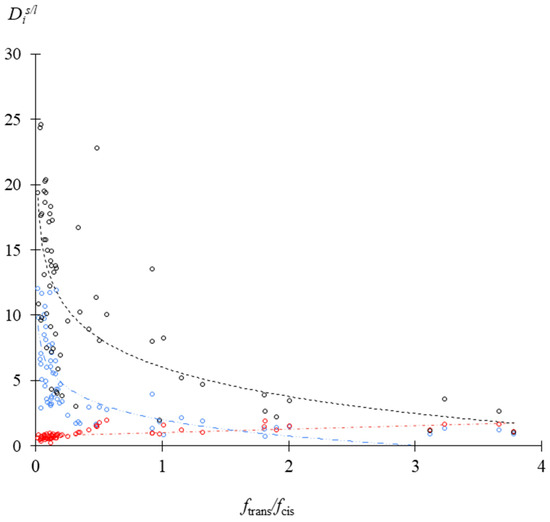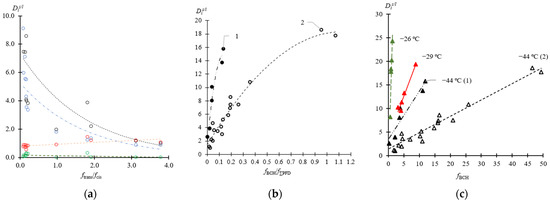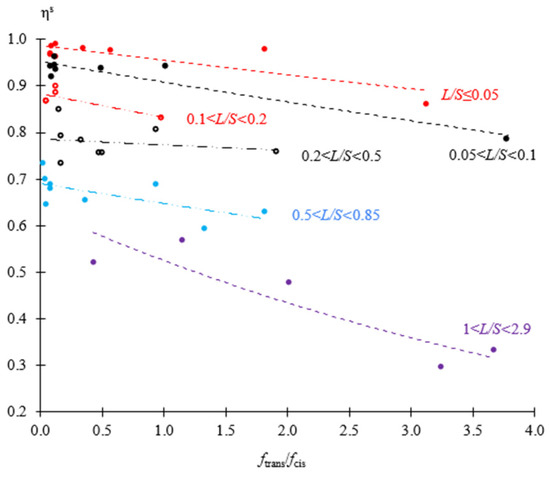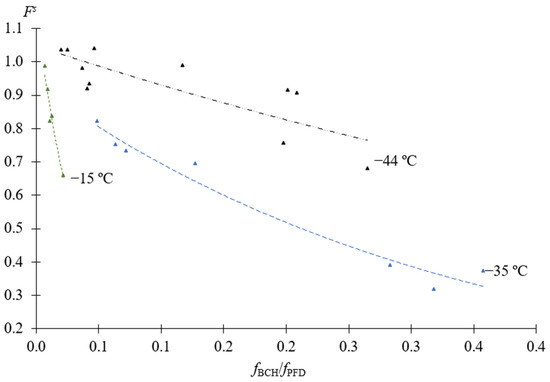Abstract
The process of crystallization separation of an industrial mixture of perfluorinated cycloalkanes was considered. The content of target products, cis- and trans-isomers of perfluorodecalin (PFD), in all initial fractions of the investigated samples of the reaction mixture was at least 70 wt.%. Based on the experimental data, the dependences of the crystallization (partition) coefficients between the solid and mother liquor (), the enrichment factor (ηs), and the separation factor (Fs) on the ratio of trans-PFD to cis-PFD, the ratio of mother liquor to solid, and crystallization temperature in the range −50–15 °C were obtained. It was shown that the values and ηs depended significantly on the concentration of trans-PFD in the initial solution, and that the value of Fs decreased as the process temperature rose.
1. Introduction
Perfluorodecalin (PFD) is used in medicine, in particular, as a component of blood substitutes [1,2] and as a perfusion fluid to transfer substances across the cell membrane. In bioengineering, PFD is used to modify biomolecules [3] and also to provide handles for purification, mass spectrometry, and 19F NMR studies in complex environments [4]. These uses have led to stringent requirements for the purity of the final product. The main method of PFD manufacturing is the electrochemical fluorination of naphthalene or decalin [5,6], which results in the formation of two optical isomers of PFD: cis-PFD and trans-PFD. This process is also associated with the partial destruction of C–C chemical bonds in the PFD molecule and the formation of various impurities, including perfluoro(butylcyclohexane) (BCH) [7,8].
Industrial methods for separating the products of the reaction of electrochemical fluorination of decalin include the distillation process [9], which is characterized by low relative volatility values, and crystallization [10,11]. The latter shows high efficiency in the final PFD purification from impurities, and is characterized by higher values of the partition coefficient, which allows individual PFD isomers of high purity to be obtained. However, the crystallization process is understudied, and requires solid–liquid phase equilibrium data regarding the investigated systems and the dependences of process indicators on various technological parameters.
The purpose of this work was to study the process of separation of an industrial PFD mixture using the crystallization method.
2. Materials and Methods
The initial mixture of PFD was obtained directly from an industrial plant. The content of the target products, cis- and trans-PFD, in all initial fractions of the studied samples of the reaction mixture was at least 70 wt.%.
To carry out the crystallization process, the initial fraction with known composition (fi) and weight was placed in a chest freezer and maintained at a constant temperature (Tsep) for at least 24 h. Next, the mother liquor was separated from the solid by decanting for 3 h in a chest freezer at Tsep. The fractions obtained were weighed and their compositions were determined.
Gas chromatography (GC) was used for analytical determination of phase compositions. All fractions were weighed using an analytical balance (±5 × 10−4 g).
3. Results and Discussion
The analysis of the initial fraction composition showed that in addition to PFD isomers, various impurities were present in the mixture. The nomenclature of the latter included approximately eight components, most of which were not identified due to the lack of relevant research required to identify their structures and the complexity of their self-concentrations. The main impurity (up to 30 wt.%) was BCH.
The array of experimental data obtained during crystallization (Figure 1) was processed in order to calculate the process indicators of the process, which are presented below in graphical form.

Figure 1.
The dependence of the partition coefficient between the solid and mother liquor on the ratio of trans-PFD/cis-PFD in the initial fraction (ftrans/fcis). Red—trans-PFD; blue—cis-PFD; black—∑PFD.
3.1. Crystallization Coefficient
The dependence of the crystallization (partition) coefficient between the solid and mother liquor (—Equation (1)) on the ratio of components in the initial fraction (fi/fj) is shown in Figure 2.
where xi and yi are the concentrations of the mixture component i in the crystalline solid and mother liquor, respectively.

Figure 2.
The dependence of the partition coefficient between the solid and mother liquor (): (a) on the ratio of trans-PFD/cis-PFD in the initial fraction (fi/fj) for components of the mixture at Tsep = −44 °C; (b) on the ratio of BCH/∑PFD in the initial fraction (fi/fj) for ∑PFD at different nomenclature and quantity of unidentified impurities at Tsep = −44 °C; (c) on the concentration of BCH in the initial fraction (fBCH) for ΣPFD at different Tsep. Dots: red—trans-PFD; blue—cis-PFD; black—∑PFD; green—BCH.
According to the experimental data (Figure 2a), the value significantly depended on the presence of trans-PFD in the initial solution. Thus, with an increase in the ratio of trans-PFD/cis-PFD, the value for the low-melting BCH tends to 0—BCH was completely absent in the solid phase; the majority of unidentified impurities were concentrated in the mother liquor ( < 1); the value had a linear dependence with the point of inversion ( at the ratio of trans-PFD/cis-PFD ≷ 1); ≥ 1 for almost all trans-PFD/cis-PFD ratios and ≫ 1 at trans-PFD/cis-PFD < 1. Thus, according to the experimental data, the crystallization of fractions with high trans-PFD content was less effective than that of fractions with high cis-PFD content. In addition, the value depended on the nomenclature and concentration of impurities in the initial fraction (Figure 2b,c—curve 1 and curve 2). The latter is very interesting, given that the melting point (Tm) of cis-PFD is lower than that of trans-PFD (Table 1). There were also clear dependences of the partition coefficient on Tsep (Figure 2c).

Table 1.
Crystallization temperatures of pure trans- and cis-PFD and BCH.
3.2. Enrichment Factor
The dependence of PFD enrichment factor into the solid (—Equation (2) [13]) on the ratio of trans-PFD/cis-PFD in the initial fraction (ftrans/fcis) at different ratios of mother liquor to solid (L/S) is shown in Figure 3.
where fi is the concentration of the component in the initial fraction, and F and S are the masses of the initial and crystalline fractions, respectively.

Figure 3.
The dependence of the enrichment factor of PFD into solid on the ratio of trans-PFD/cis-PFD in the initial fraction (ftrans/fcis) at different ratios of mother liquor to solid (L/S).
From Figure 3, it follows that decreased insignificantly with an increase in the ratio ftrans/fcis (horizontally) at all values of L/S. In addition, for ftrans/fcis = const, an increase in the proportion of the mother liquor in relation to the solid led to a decrease (vertically) in the value of the PFD enrichment factor from the mixture .
3.3. Separation Factor
The dependence of the separation factor of cis-PFD on the solid (—Equation (3) [13]) on the ratio BCH/ΣPFD in the initial fraction (fBCH/fPFD) at different temperatures of the crystallization process Tsep is shown in Figure 4.

Figure 4.
The dependence of the separation factor of cis-PFD Fs on the ratio fBCH/fPFD at different Tsep values.
It follows from Figure 4 that an increase in the BCH concentration in the initial fraction led to a decrease in the value at all Tsep. The effect of the BCH relative concentration on the value increased significantly as Tsep increased. It should be noted that at Tsep = −44 °C, which is close to the BCH crystallization temperature, the value of was close to 1; enrichment of the solid phase of cis-PPD practically did not take place. However, BCH entrained other law-melting impurities into the mother liquor.
4. Conclusions
The study considered the separation via crystallization of an industrial mixture of PFD and its impurities. BCH acted as the main impurity. During the crystallization process, in addition to the separation of PFD and impurities, a partial separation of PFD isomers occurred. Despite the higher melting point of trans-PFD, its partition coefficient was less than that of cis-PFD (). This phenomenon can presumably be associated with the presence of a significant amount of BCH in the investigated samples, which affected the solid–liquid phase equilibrium. It should be noted that despite the difficulties in processing the array of experimental data associated with the multicomponent nature of the mixture and the mutual, possibly multidirectional, influence of variables affecting the indicators of the crystallization process, a number of explicit temperature and concentration dependences were observed for the mixture.
Author Contributions
Conceptualization, E.V.L., A.V.K. and A.V.P.; methodology, E.V.L.; validation, A.V.P., E.V.L. and A.V.K.; formal analysis, S.Y.K.; investigation, A.V.K. and N.N.K. (Nikolai N. Kuritsyn); resources, S.Y.K.; writing—original draft preparation, A.V.K. and A.V.P.; writing—review and editing, A.V.P.; visualization, A.V.K. and A.V.P.; supervision, N.N.K. (Nikolai N. Kulov) and A.V.P.; project administration, A.V.P., E.V.L. and N.N.K. (Nikolai N. Kulov).; funding acquisition, A.V.P., E.V.L., S.Y.K. and N.N.K. (Nikolai N. Kulov). All authors have read and agreed to the published version of the manuscript.
Funding
This study was financially supported by the Russian Science Foundation, project no. 22-22 29-00791, https://rscf.ru/en/project/22-29-00791/ (accessed on 11 July 2023).
Institutional Review Board Statement
Not applicable.
Informed Consent Statement
Not applicable.
Data Availability Statement
All data are available on request.
Conflicts of Interest
The authors declare no conflict of interest.
References
- Maevsky, E.; Ivanitsky, G.; Bogdanova, L.; Aksenova, O.; Karmen, N.; Zhiburt, E.; Senina, R.; Pushkin, S.; Maslennikov, I.; Orlov, A.; et al. Clinical Results of Perftoran Application: Present and Future. Artif. Cells Nanomed. Biotechnol. 2005, 33, 37–46. [Google Scholar] [CrossRef] [PubMed]
- Gervits, L.L. Perfluorocarbon-based blood substitutes Russian experience. In Fluorine in Medicine in the 21st Century; UMIST: Manchester, UK, 1994; pp. 1–9. [Google Scholar]
- Sykłowska-Baranek, K.; Pilarek, M.; Cichosz, M.; Pietrosiuk, A. Liquid Perfluorodecalin Application for In Situ Extraction and Enhanced Naphthoquinones Production in Arnebia euchroma Cell Suspension Cultures. Appl. Biochem. Biotechnol. 2014, 172, 2618–2627. [Google Scholar] [CrossRef] [PubMed]
- Miller, M.A.; Sletten, E.M. Perfluorocarbons in Chemical Biology. ChemBioChem 2020, 21, 3451–3462. [Google Scholar] [CrossRef] [PubMed]
- Aleshinskii, V.V.; Novikova, M.D.; Shabalin, D.A. Method of Producing Perfluorocycloalkanes. RU 2451006 C1, 20 May 2012. [Google Scholar]
- Fuss, R.W.; Radeck, W.; Ruediger, S. Process for Fluorinating Functional Organic Compounds by Means of Cobalt Trifluoride under Mild Conditions. DE 4337712 A1, 11 May 1995. [Google Scholar]
- Kambur, P.S.; Pashkevich, D.S.; Alekseev, Y.I.; Yampolskii, Y.P.; Alentev, A.Y. Interaction of Perfluorinated Fluids with Fluorine in Gas-Liquid Reactor. Russ. J. Appl. Chem. 2019, 92, 661–666. [Google Scholar] [CrossRef]
- Gervits, L.L.; Snegirov, V.F.; Makarov, K.N.; Galakhov, M.V.; Mukhin, V.Y. Non-chair conformation of cis isomers of 1,4-disubstituted perfluorocyclohexanes. Bull. Acad. Sci. USSR Div. Chem. Sci. 1987, 36, 2664–2665. [Google Scholar] [CrossRef]
- Polkovnichenko, A.V.; Lupachev, E.V.; Kisel, A.V.; Kvashnin, S.Y.; Kulov, N.N. Perfluoro (7-Methylbicyclo [4.3.0] Nonane) and Perfluoro (Butylcyclohexane): Physicochemical, Thermophysical, and Spectral Data. J. Chem. Eng. Data 2023, 68, 499–517. [Google Scholar] [CrossRef]
- Gorelenko, S.; Zachesova, U.V.; Osipov, G.N.; Kazakov, P.V.; Mirzabekova, N.S.; Eleev, A.F. Preparation of the high purity perfluorodecalin. Fluor. Notes 2016, 5, 3. [Google Scholar] [CrossRef]
- Bispen, T.A.; Kochnev, A.D.; Moldavskij, D.D.; Sergeeva, A.A. Method of Purifying Perfluorodecalin. RU 2544849 C1, 20 March 2015. [Google Scholar]
- Domalski, E.S.; Hearing, E.D. Heat Capacities and Entropies of Organic Compounds in the Condensed Phase. Volume III. J Phys. Chem. Ref. Data 1996, 25, 1–525. [Google Scholar] [CrossRef]
- Gelperin, N.I.; Nosov, G.A. Fundamentals of Fractional Crystallization Techniques; Khimiya Publ.: Moscow, Russia, 1986; p. 304. [Google Scholar]
Disclaimer/Publisher’s Note: The statements, opinions and data contained in all publications are solely those of the individual author(s) and contributor(s) and not of MDPI and/or the editor(s). MDPI and/or the editor(s) disclaim responsibility for any injury to people or property resulting from any ideas, methods, instructions or products referred to in the content. |
© 2023 by the authors. Licensee MDPI, Basel, Switzerland. This article is an open access article distributed under the terms and conditions of the Creative Commons Attribution (CC BY) license (https://creativecommons.org/licenses/by/4.0/).